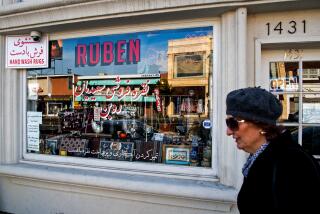Kara Kush by Idries Shah<i> (Stein & Day: $17.95; 575 pp.) </i>
The distinguished Afghan author Idries Shah has written 30 books, chiefly on Sufi mysticism, that have sold 5 million copies in 12 languages. Now, at 62, he has published his first work of fiction, though it is so closely based on fact that, far from posting any disclaimer of relation to actual persons, he has apparently for the most part only disguised names to protect his sources.
After many years in the West, Shah slipped back into Afghanistan at the height of that horrific war and the true stories he collected weave like a caravan through âKara Kush,â against the kaleidoscopic landscape of Afghanistanâs history. For Shah has brought all his skills to bear, blending considerable scholarship with raw experience, and passion with a Sufiâs love ofparadox. The result is a book as remarkable as the country it portrays.
âKara Kushâ opens with the last hour of mortally wounded Capt. Juma Sherzada, âtwenty-fifth hereditary battle lord of Sher Qalaâ in northern Afghanistan and recent defector from the Afghan army. In an ambush of Soviet tanks, his village band of moujahedeen has captured âloading and defense instructionsâ for a secret cargo of gold--treasure sacked from Delhi in 1756 by Ahmad Shah Durrani, modern Afghanistanâs first king. Now worth $400 billion, the hoard is to be shipped to the Soviet Union, thus upsetting the economic balance of superpowers.
As a Soviet helicopter gunship lands to take Juma prisoner, he passes the plans to Haidar, his hereditary weapons-bearer and the village mayor, for him to take to Kara Kush, leader of a most successful group of resistance fighters. Then, aloft in the gunship, Juma pulls the pin of a grenade hidden under his shirt.
Kara Kushâs struggle to prevent this pillage is the storyâs grounding, but his very name signals complexities to come: In Afghan-Turki it means âeagle,â and in Dari-Persian âinstant kill.â
Before the Soviet invasion The Eagle was Adam Durany, U.S.-educated professor of technology at Kabul University. His cohorts include Noor Sharifi, an aristocratic childhood friend and worthy successor to Afghanistanâs long tradition of heroines; 15-year-old Aslam Jan; Private Zelikov, gleeful defector from the Soviet Union as much as the Red Army; and Maryam, a young Jewish Kabuli architect who is introduced with a fascinating disquisition on the hotly contested theory that Afghanistanâs largest tribe, the Pashtuns, may be one of the 10 lost tribes of Israel.
But there are a hundred characters in this huge book, quickly and vividly drawn. Many, like Shah himself, are Afghans returned from abroad to help the resistance. As the rebels crisscross the country from the treacherous glaciers of the Hindu Kush to the southern Desert of Death, each new glimpse of the old silk route is a wellspring for tales of Afghanistanâs dead and living past--the latter most extraordinarily personified by an order of Dervish knights using the honeycomb caves at Bamiyan as their monastery, as in the Middle Ages, and prepared to go up against Soviet tanks in chain mail and with weapons kept from the third Anglo-Afghan war.
The story ends with a stunning, almost unbearable battle sequence that includes a âsurgical strikeâ by a covert force from the United States, just one instance where it would be interesting to know the difference between truth and fiction.
The tension of âKara Kush,â though, comes not so much from a linear plot as a masterful series of digressions. Indeed, in structure it is less like a novel than a cross between the âHoly Koranâ and the âCanterbury Tales.â It is made up of 15 books, each with a title, several chapters, and a now-ironic epigraph taken from military writings.
The Soviet âLimited Fraternal Contingentâ has waged a brutal war of atrocity and attrition in Afghanistan for almost seven years, pairing hideously sophisticated new weaponry with napalm, with the âyellow rainâ of mycotoxin poison, and--perhaps cruelest of all--with bright knickknack bombs that look like toys or watches and maim children 10 times more often than adults.
The Afghans, Shah says, call the Soviet troops âNikolaisâ--a pun on the Russian name that in Dari means âIâm no goodâ--and fight back with astonishing ingenuity and a heroism born of profound belief. Grenades thrown by slingshot, bombs dangled from kites, and even the âhellish cacophonyâ of captured Soviet bugles augment tragically inadequate arsenals. Yet Shah also has sympathy for Soviet conscripts who were told they would be fighting Americans and who die without knowing why. âThe detritus of death from soldiersâ pockets . . . Russian army pay books, an officerâs epaulet, boxes of almost unstrikeable Estonian matches . . . was the same the world over, sad and irrelevant.â
âKara Kushâ has three flaws.
First, Shah writes with the absolute moral certainty of 20/20 hindsight. By contrast to the wealth of cultural detail, he is dismissive of the history of the Left in Afghanistan and the pressures that contributed to its haphazard accession. Further, he oversimplifies what led to the invasion: There is as much evidence to suggest it was a panic move to secure a crucial border as there is evidence that it was the intended culmination of a scheme.
Second, scenes are often crippled by too much information about the munitions at hand.
Third, âKara Kushâsâ characters tend to be dwarfed by its sweep and are seen only in relation to the war. Even guerrillas have private moments, and I hungered for just one scene of Noor and Adam breaking bread, talking intimately about what life had seemed to promise before the invasion.
But âKara Kushâ is not a story, it is the whole story--magnificently written in the blood of a courageous people. The overwhelming sense, after reading Shahâs great testament, is that their story matters. So precious a nation must not lose this war.
More to Read
Sign up for our Book Club newsletter
Get the latest news, events and more from the Los Angeles Times Book Club, and help us get L.A. reading and talking.
You may occasionally receive promotional content from the Los Angeles Times.








